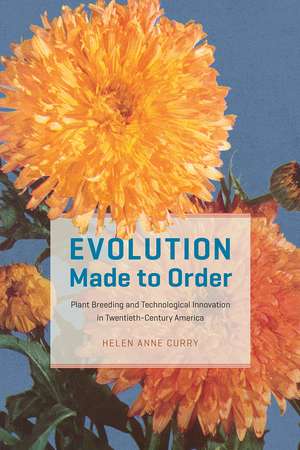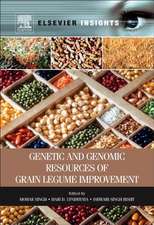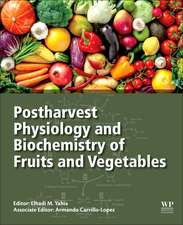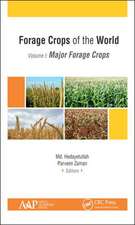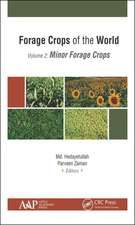Evolution Made to Order: Plant Breeding and Technological Innovation in Twentieth-Century America
Autor Helen Anne Curryen Limba Engleză Paperback – 6 iul 2021
Plant
breeders
have
long
sought
technologies
to
extend
human
control
over
nature.
Early
in
the
twentieth
century,
this
led
some
to
experiment
with
startlingly
strange
tools
like
x-ray
machines,
chromosome-altering
chemicals,
and
radioactive
elements.
Contemporary
reports
celebrated
these
mutation-inducing
methods
as
ways
of
generating
variation
in
plants
on
demand.
Speeding
up
evolution,
they
imagined,
would
allow
breeders
to
genetically
engineer
crops
and
flowers
to
order.
Creating
a
new
food
crop
or
garden
flower
would
soon
be
as
straightforward
as
innovating
any
other
modern
industrial
product.
InEvolution Made to Order, Helen Anne Curry traces the history of America’s pursuit of tools that could intervene in evolution. An immersive journey through the scientific and social worlds of midcentury genetics and plant breeding and a compelling exploration of American cultures of innovation,Evolution Made to Orderprovides vital historical context for current worldwide ethical and policy debates over genetic engineering.
InEvolution Made to Order, Helen Anne Curry traces the history of America’s pursuit of tools that could intervene in evolution. An immersive journey through the scientific and social worlds of midcentury genetics and plant breeding and a compelling exploration of American cultures of innovation,Evolution Made to Orderprovides vital historical context for current worldwide ethical and policy debates over genetic engineering.
Preț: 251.00 lei
Nou
Puncte Express: 377
Preț estimativ în valută:
48.03€ • 52.33$ • 40.47£
48.03€ • 52.33$ • 40.47£
Carte disponibilă
Livrare economică 02-16 aprilie
Livrare express 18-22 martie pentru 31.97 lei
Preluare comenzi: 021 569.72.76
Specificații
ISBN-13: 9780226790862
ISBN-10: 022679086X
Pagini: 295
Ilustrații: 29 halftones
Dimensiuni: 152 x 229 x 30 mm
Greutate: 0.44 kg
Editura: University of Chicago Press
Colecția University of Chicago Press
ISBN-10: 022679086X
Pagini: 295
Ilustrații: 29 halftones
Dimensiuni: 152 x 229 x 30 mm
Greutate: 0.44 kg
Editura: University of Chicago Press
Colecția University of Chicago Press
Notă biografică
Helen Anne Curry is the Peter Lipton Lecturer in History of Modern Science and Technology at the University of Cambridge.
Cuprins
List of Abbreviations
Introduction
Part 1 Evolution by X-ray: The Industrialization of Biological Innovation
1 Mutation Theories
2 An Unsolved Problem
3 Speeding Up Evolution
4 X-rays in the Lab and Field
5 Industrial Evolution
Part 2 Tinkering with Chromosomes: Colchicine in the Lab and Garden
6 Artificial Tetraploidy
7 Evolution to Order
8 Better Evolution through Chemistry
9 Tinkering Technologists
10 The Flower Manufacturers
Part 3 Atoms for Agriculture: Evolution in a Large Technological System
11 Radiation Revisited
12 Mutation Politics
13 An Atomic-Age Experiment Station
14 Atomic Gardens
15 The Peaceful Atom in Global Agriculture
Epilogue
Acknowledgments
Notes
Bibliography
Index
Introduction
Part 1 Evolution by X-ray: The Industrialization of Biological Innovation
1 Mutation Theories
2 An Unsolved Problem
3 Speeding Up Evolution
4 X-rays in the Lab and Field
5 Industrial Evolution
Part 2 Tinkering with Chromosomes: Colchicine in the Lab and Garden
6 Artificial Tetraploidy
7 Evolution to Order
8 Better Evolution through Chemistry
9 Tinkering Technologists
10 The Flower Manufacturers
Part 3 Atoms for Agriculture: Evolution in a Large Technological System
11 Radiation Revisited
12 Mutation Politics
13 An Atomic-Age Experiment Station
14 Atomic Gardens
15 The Peaceful Atom in Global Agriculture
Epilogue
Acknowledgments
Notes
Bibliography
Index
Recenzii
“Curry
offers
a
fascinating
historical
journey
through
the
American
scientific
and
social
worlds
of
induced-mutation
work.
Through
extensive
research,
she
convincingly
establishes
that
biologists’
obsession
with
plant
mutation
breeding
did
not
begin
with
molecular
biology
and
recombinant
DNA
but,
rather,
with
the
tools
of
chemical
mutagenesis
and
radiobiology.
Her
lively
account
resurrects
unknown
actors,
important
institutional
contexts,
and
forgotten
cultural
fads,
and
her
thoughtful
consideration
of
the
successes
and
failures
of
their
collective
scientific
endeavors
provides
some
much-needed
historical
context
for
current
ethical
and
policy
debates
over
genetic
engineering.Evolution
Made
to
Orderis
a
narrative
account
that
is
both
accessible
and
scholarly.
It
makes
an
important
contribution
to
the
historiographies
of
biology
and
technology,
and
treats
with
appropriate
parity
the
roles
of
its
scientific
and
amateur
historical
actors.
It
is,
in
a
word,
brilliant.”
"In this fascinating, well-researched history of genetic innovation, Curry explores the hype, intensive investigation, and, ultimately, the disappointment accompanying the application of new technologies offering the promise of human control over plant evolution to breed superior agricultural and horticultural crops in the early to mid-20th century. The utilization of these tools for plant breeding is placed in the broader context of innovations in the electromechanical, chemical, and nuclear industries and the desire to control living organisms in a manner similar to any other industrial product. Certain historical events, such as America’s entry into World War II and the subsequent desire for national self-sufficiency that developed, helped fuel the hope that these technologies could deliver the necessary genetic advances, despite the available evidence to the contrary. Fascinating and entertaining throughout, this historical account of genetic technological innovation helps provide context for discussion over current, and by every measure much more successful, genetic engineering technologies utilized for plant improvement and the societal, ethical, and ecological questions surrounding them. Highly recommended."
"Curry’s book is a clearly written and original history charting the activities of Americans who developed tools designed to manipulate genes and chromosomes in the early to mid-twentieth century. She focuses on three technologies: use of X-rays, chemical manipulation, and gamma radiation. These stories illustrate how readily scientists and the American public exploited new technologies as they became available, always with the hope of speeding up and controlling evolution."
"In her book Evolution Made to Order, Curry elucidates three major innovations in American plant breeding techniques during the 20th century—the use of X-rays, colchicine, and radioisotopes to bring about mutations and speed up evolution. Along the way, she introduces us to important plant breeders and scientists, including Albert Blakeslee, David Burpee, Bernard Nebel, Mable Ruttle, Arnold Sparrow, Lewis Stadler, Ralph Singleton, and others who strove to feed the world."
"Curry’s clear and appealing writing, and her layered analysis, make this a wonderful and important book."
"Curry’s history is well researched, well written, clear, and subtle.... She does us a service by taking 'failures' seriously. The bias toward studying successes blinds us to the alternative paths that seemed just as realistic, in their time and place, as the eventual successes. We need more studies of scientific and technological dead ends if we are to gain a full understanding of the ways scientists and engineers tried to change the world at any given time."
"Curry identifies several cross-cutting themes that strengthen her argument for a shared technological and industrial vision. . . . Throughout the book Curry raises key questions and builds important arguments, to which she returns in a suggestive Epilogue, about the overarching industrial values (to which I would add corporate values) that dominated the context of doing science in the twentieth century. She demonstrates the very real overlap of scientific, commercial, and industrial practices, and what might be called an obsession with prediction and control extending from the management of industrial processes to the management of life."
"Providing compelling perspectives on consumerism, marketing, and the everyday roles of technology and science in the United States in the twentieth century, [Curry's] study tracks efforts to produce mutations in plants. . . . As a study of the marketing of scientific promise, this book is filled with rich details and wonderful illustrations of the exuberance."
"Informative, engaging, and entertaining. This book will already be familiar to historians of technology and science with an interest in agriculture—who will be repaid by a return to the volume and its evergreen themes. Generalists and specialists in other areas should take note of this fine model of scholarship with broad relevance. It also deserves the attention of readers with wider interests in technology, amateur and professional science, and science and technology policy. This is exactly the kind of well-reasoned and clearly written analysis that one hopes policymakers or anyone seeking to employ technology should be reading in producing solutions to the problems of food in the future. . . . This volume remains relevant and timely at least in part because of its richness—which this review can hardly capture—of analysis and exposition in thinking about plants and their co-evolved humans."
“Curry recovers a neglected history of biotechnology with verve and vivid detail. Decades before recombinant DNA, eager breeders and horticulturalists exploited mutant-generating techniques from chemistry and nuclear energy to improve crops and ornamental plants. As she shows, GMOs are only the latest chapter of ‘evolution to order’ in agriculture.”
“This well-written book is in part a contribution to the history of plant breeding. But more than that, it is a study of ‘technological utopianism’: the fervent belief that new methods of inducing mutation could transform breeding and thus boost the agricultural economy. Of particular interest is Curry’s demonstration that although the new technology was a failure from the breeders’ point of view, it nonetheless retained widespread support from a range of extrascientific organizations—seed companies, industrial firms, government agencies—who perceived it as a solution to their own quite different problems.”
“Early and mid-twentieth-century geneticists and plant breeders dreamed of finding ways to speed up evolution. Evolution Made to Order uses a diverse set of sources, ranging from archives and newspapers to seed catalogs, to explore how and why American researchers hoped to use radiation to produce new commercial plant varieties. Curry’s innovative approach to the history of biotechnology deserves a wide audience among historians of science, technology, and medicine.”
Descriere
Plant breeders have long sought technologies to extend human control over nature. Early in the twentieth century, this led some to experiment with startlingly strange tools like x-ray machines, chromosome-altering chemicals, and radioactive elements. Contemporary reports celebrated these mutation-inducing methods as ways of generating variation in plants on demand. Speeding up evolution, they imagined, would allow breeders to genetically engineer crops and flowers to order. Creating a new food crop or garden flower would soon be as straightforward as innovating any other modern industrial product.
In Evolution Made to Order, Helen Anne Curry traces the history of America’s pursuit of tools that could intervene in evolution. An immersive journey through the scientific and social worlds of midcentury genetics and plant breeding and a compelling exploration of American cultures of innovation, Evolution Made to Order provides vital historical context for current worldwide ethical and policy debates over genetic engineering.
In Evolution Made to Order, Helen Anne Curry traces the history of America’s pursuit of tools that could intervene in evolution. An immersive journey through the scientific and social worlds of midcentury genetics and plant breeding and a compelling exploration of American cultures of innovation, Evolution Made to Order provides vital historical context for current worldwide ethical and policy debates over genetic engineering.
